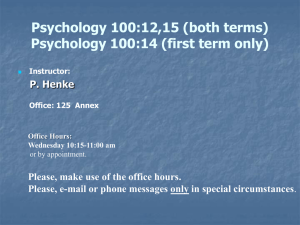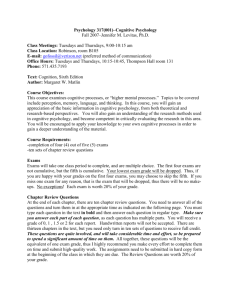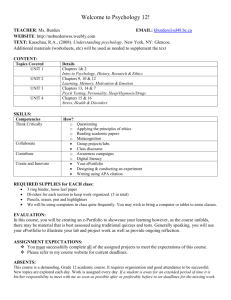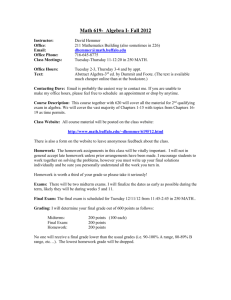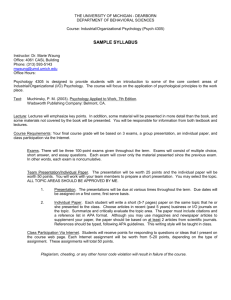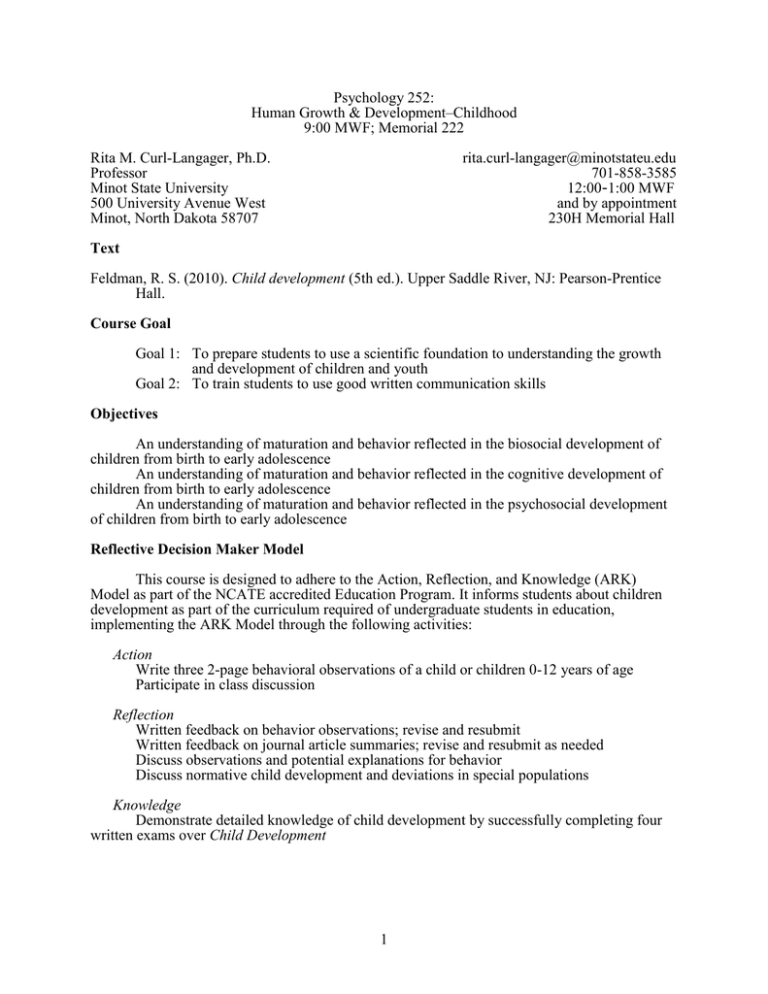
Psychology 252:
Human Growth & Development–Childhood
9:00 MWF; Memorial 222
Rita M. Curl-Langager, Ph.D.
Professor
Minot State University
500 University Avenue West
Minot, North Dakota 58707
rita.curl-langager@minotstateu.edu
701-858-3585
12:00-1:00 MWF
and by appointment
230H Memorial Hall
Text
Feldman, R. S. (2010). Child development (5th ed.). Upper Saddle River, NJ: Pearson-Prentice
Hall.
Course Goal
Goal 1: To prepare students to use a scientific foundation to understanding the growth
and development of children and youth
Goal 2: To train students to use good written communication skills
Objectives
An understanding of maturation and behavior reflected in the biosocial development of
children from birth to early adolescence
An understanding of maturation and behavior reflected in the cognitive development of
children from birth to early adolescence
An understanding of maturation and behavior reflected in the psychosocial development
of children from birth to early adolescence
Reflective Decision Maker Model
This course is designed to adhere to the Action, Reflection, and Knowledge (ARK)
Model as part of the NCATE accredited Education Program. It informs students about children
development as part of the curriculum required of undergraduate students in education,
implementing the ARK Model through the following activities:
Action
Write three 2-page behavioral observations of a child or children 0-12 years of age
Participate in class discussion
Reflection
Written feedback on behavior observations; revise and resubmit
Written feedback on journal article summaries; revise and resubmit as needed
Discuss observations and potential explanations for behavior
Discuss normative child development and deviations in special populations
Knowledge
Demonstrate detailed knowledge of child development by successfully completing four
written exams over Child Development
1
Psychology 252
Fall 2009
Observations
You will be required to complete three observations of children between birth and 12
years of age and to write summaries of your observations. You may observe the reality show
John and Kate + 8 or schedule a volunteer as soon as you have the required permissions. Observe
children at home or in day care, preschool, or grade school settings with the permission of the
teacher and/or parents as appropriate. Please contact me as soon as possible, if you need help
finding a child to observe.
@ 30 points
Exams
You are required to take four exams throughout the semester. Exam 1 will cover four
chapters; the second and third exams will test three chapters each; the final exam will be
comprehensive across chapters 1 through 13. Tests will include multiple choice and essay
questions. The final exam will be of greater value than the other three tests.
Tests 1, 2, & 3 @100 points
Test 4 150 points
Participation
You will be asked to participate in class throughout the semester to summarize readings,
synthesize information from the readings, and present ideas that are logical extensions of the
material. Prepare your questions before class begins whenever possible.
50 points
Timeline
08/26 Introduction and Overview
28 Chapter 1 – An Introduction to Child Development
08/31 Chapter 1, continued
09/02 Chapter 2 – Theoretical Perspectives and Research
04
”
09/07 Labor Day Holiday
09 Chapter 2, continued
11 Chapter 3 – The Start of Life
09/14 Chapter 3, continued
16
”
18 Chapter 4 – Prenatal Birth and the Newborn Infant
09/21 Chapter 4, continued
23 Finish Topics/Review
09/25 Exam 1 – Chapters 1-4
09/28 Chapter 5 – Physical Development in Infancy
30
”
10/02
”
10/05 Chapter 6 – Cognitive Development in Infancy
07
”
09
”
2
/ Observation 1
Psychology 252
Fall 2009
10/12 Chapter 7 – Physical Development and Health in the Preschool Years
14
”
16
”
10/19 Finish Topics/Review
10/21 Exam 2 – Chapters 5-7
23 Chapter 8 – Physical Development in the Preschool Years
/ Observation 2
10/26 Chapter 8, continued
28
”
30 Chapter 9 – Cognitive Development in the Preschool Years
11/02 Chapter 9, continued
04
”
06 Chapter 10 – Social and Preschool Development in the Preschool Years
11/09 Chapter 10, continued
11 Veterans Day Holiday
13
”
11/16 Finish Topics/Review
11/18 Exam 3 – Chapters 8-10
20 Chapter 11—Physical Development in Middle Childhood
11/23 Chapter 11, continued
25 Chapter 12 – Cognitive Development in Middle Childhood
27 Thanksgiving Holiday
/ Observation 3
11/30 Chapter 12, continued
12/02
”
04 Chapter 13 – Social and Personality Development in Middle Childhood
12/07 Chapter 13, continued
09
”
11 Finish Topics/Review
12/14 Final Exam – Monday, 8:00 – 9:50 p.m.
Grading
Observations
Exams
Class Participation
Total Points
90
450
60
-----------600
Final Grades
A
B
C
D
F
90 - 100% (maximum points earned by top student)
80 – 89%
70 – 79%
60 – 69%
59% or below
3
Psychology 252
Fall 2009
Observations
Begin with an overall plan or purpose of the observations clearly in mind before you start.
Observation Procedures
Get permission to conduct the observation. It is your responsibility to behave ethically.
Look at page 41 in your textbook for more complete written explanations. If you miss the
discussion in class, talk with me after class or make an appointment to review some basic
strategies.
Do not interact with the child you are observing; simply observe the child in the natural
setting. You change the environment more seriously by interacting with it than merely being
there. Children tend to forget that you are there if you do not make eye contact or talk with them.
If you know the child, explain that you are doing homework, and that you will talk with them
later when you are finished.
Record what you observe, describing the setting and sequence of behavior that occurred
in enough detail that you can expand on it later. Be careful to stick to the facts of what the
subject said and did, and how others responded to the subject. Try not to interpret actions, draw
conclusions, or assign labels. Summary terms like angry, intelligent, concerned, or easy-going do
not tell the reader what the child actually did while you observed him/her. Explain what the child
did, e.g., threw things, hit, yelled; talked in complete sentences; put an arm around another child;
frowned, stomped her feet, or cried.
Written Summary of Observation
The assignment is to write three (3) 2-page behavioral observations of children between
birth and 12 years of age.
Please look at page 41 in Feldman for basic guidelines to conduct observations.
Use the writing style for psychology explained in the Publication Manual of the
American Psychological Association (5th ed.) available at the reference desk in the library or at
the MSU bookstore.
Record the date, time, and the child’s pseudonym, the child’s age, the setting in which the
child was observed, the duration of the observation.
Explain what you observed and what the child demonstrated. Explain the child’s behavior
in the order in which the behavior occurred, describing activities in which the child participated,
and the interaction that occurred between your subject and other individuals in the setting.
Describe the activity changes that occurred, and explain events that influenced the behavior
changes such as parental directions. Sometimes there will not seem to be any reason why things
happen. It is important to look at a variety of behavior such as language (record a few phrases
that the child says), motor skills, cognitive skills, self-help, and social skills.
At the end of the observation summary, you may draw conclusions about the child based
on the information that you have already provided.
General Writing Guidelines
Read chapters 2 and 5 of the Publication Manual of the American Psychological
Association for guidelines in technical writing. Be sure to follow these:
4
Psychology 252
Fall 2009
Use a cover page with your name, the course number, the date that the paper is due.
Use 1” margins on 8 ½ X 11 paper.
Use 12-point type in Times New Roman or Courier.
Double space the narrative throughout the paper; do not leave empty lines.
Have 25 lines per page—under “Format”, click on “Paragraph” and go to “Line spacing;” set
line space to “double” to get the required lines per page. Be sure that spacing “before and after”
boxes are at 0.
Use proper English; avoid colloquial phrases.
Be sure descriptions include observable and measurable behavior; avoid inferences about
what the participants are thinking or intending.
Use past tense throughout the descriptive narrative.
Avoid the use of first person as much as possible.
In the summary, avoid terms or phrases that suggest you know what the child was thinking;
explain what the child did that suggests what the child might have been thinking.
Please ask questions in class if you have any—it helps everyone, or send me questions via
email (rita.curl-langager@minotstateu.edu).
5

